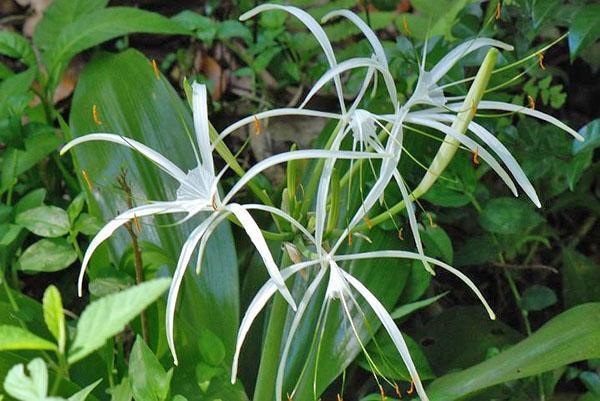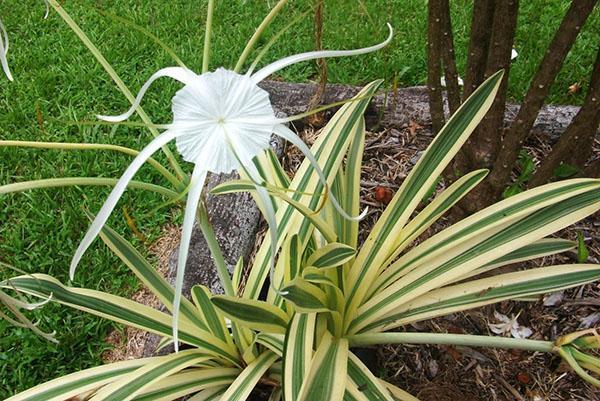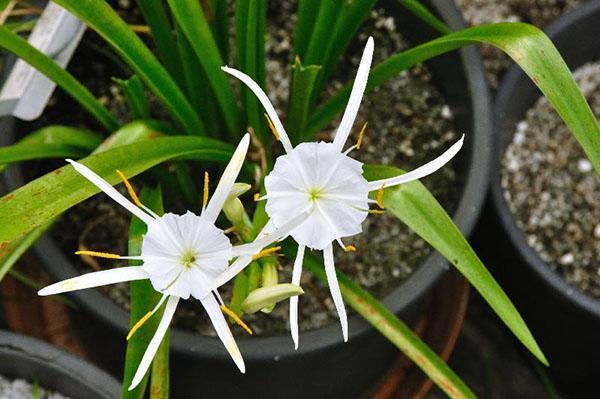Home care for hymenokallis
 Plants of the genus Hymenokallis or spider lilies came to Europe in the era of the Great Geographical Discoveries, but did not become as popular as the hippeastrum or the South African amaryllis. In fact, if hymennocallis appears on the window, home care differs little from caring for other bulbous plants, but a rather rare plant becomes an original decoration of the window sill.
Plants of the genus Hymenokallis or spider lilies came to Europe in the era of the Great Geographical Discoveries, but did not become as popular as the hippeastrum or the South African amaryllis. In fact, if hymennocallis appears on the window, home care differs little from caring for other bulbous plants, but a rather rare plant becomes an original decoration of the window sill.
Features of the home flower hymenokallis

At home, Hymenocallis caribbean or Hymenocallis caribaea, an evergreen species, is most often grown.
This indoor hymenokallis flower has:
- large, up to 10 cm in diameter, pear-shaped bulb;
- pointed, lanceolate, up to a meter long and up to 7 cm wide, leaves of a dark green or variegated color;
- vertical, hollow inside peduncle with an umbellate inflorescence at the top.
Flowering occurs in the winter months and can last up to 100–120 days. On the peduncle, from 3 to 7 large white flowers of a characteristic "spider-like" shape open in succession.
Hymenokallis care at home
 With an exotic appearance, the hymenokallis flower does not differ in its capricious character, therefore, the basic requirements for care are very close to the care that other decorative bulbous plants are obtained in the conditions of the house.
With an exotic appearance, the hymenokallis flower does not differ in its capricious character, therefore, the basic requirements for care are very close to the care that other decorative bulbous plants are obtained in the conditions of the house.
In order for hymenokallis to feel good, develop, bloom and grow a bulb, it needs to create the right conditions.
Lighting should be bright and long lasting. Even in winter, evergreen species require a lot of sun, so it is best to create for them additional illumination for 10-12 hours a day. The optimal arrangement of a pot with a hymenokallis flower is a south window.
During the period of foliage growth, that is, in spring and summer, the plants do well at normal room temperature. As part of hymenokallis care, the pots can be taken out into the air, protecting the plants from the cold wind.
In winter, especially when there is a lack of light, the temperature is lowered to 12-18 ° C, depending on the species. If installed phytolampsAn evergreen, such as the Caribbean hymenokallis, can remain at room temperature.
These conditions are not suitable for deciduous species. Their dried bulbs are transferred to a cool place, where they are stored until the sprouts awaken at a temperature of 10-12 ° C.
 Watering the plant is one of the most important steps in caring for hymenokallis at home. On the one hand, the culture does not tolerate excessive dryness of the soil, to which it responds with wilting of leaves and rapid loss of flowers. On the other hand, abundant watering threatens waterlogging and decay of the root system and the bulb itself. To prevent this from happening, you need to carefully monitor the condition of the soil and the hymenokallis flower.
Watering the plant is one of the most important steps in caring for hymenokallis at home. On the one hand, the culture does not tolerate excessive dryness of the soil, to which it responds with wilting of leaves and rapid loss of flowers. On the other hand, abundant watering threatens waterlogging and decay of the root system and the bulb itself. To prevent this from happening, you need to carefully monitor the condition of the soil and the hymenokallis flower.
When the plants have bloomed, and only foliage is above the soil surface, watering is slightly reduced, but not stopped.If a deciduous species grows in the house, watering is stopped for a short-term rest.
With moistening the soil, you can combine such a hymenokallis care procedure as wiping the foliage with a damp cloth. This will improve the appearance of the flower and its well-being on hot days and with excessively dry air.
 Throughout the entire period of activity, plants are fed using ready-made, liquid mixtures for ornamental flowering or bulbous species. Interval between dressing is 2-3 weeks.
Throughout the entire period of activity, plants are fed using ready-made, liquid mixtures for ornamental flowering or bulbous species. Interval between dressing is 2-3 weeks.
When fertilizing hymenokallis, you should carefully use fertilizing with a high nitrogen content. On the one hand, such compositions stimulate the development of foliage and the growth of the bulb, but on the other hand, an excess of this element negatively affects the quality and duration of flowering, and the bulb unprepared for wintering sometimes rots.
For the entire wintering period, the indoor hymenocallis flower, especially deciduous species, stop fertilizing.
Planting and caring for hymenokallis
If necessary, the plant can be easily transferred to a new pot. Hymenokallis is relatively calm about the planting and care that follows. But transshipment often knocks down the rhythm habitual for culture, flowering is postponed, so they try to replant it not more often than after 3 or 4 years.
And yet, if the roots have completely braided the entire lump of the substrate, or children have appeared on the bulb, a transplant cannot be avoided. The hymenokallis flower needs spacious containers, where a rather thick drainage layer is necessarily made at the bottom.
 Then the container is filled with a substrate and the bulb is buried in the center by half or two-thirds. The soil is compacted and moisturized abundantly.
Then the container is filled with a substrate and the bulb is buried in the center by half or two-thirds. The soil is compacted and moisturized abundantly.
The best potting mix for hymenocallis is one that provides the plant with nutrients, air and moisture. Therefore, the substrate is mixed from garden soil, humus, coarse sand and peat so that the resulting soil is loose and well structured. The prepared mixture is steamed or sterilized in another way. To reduce the risk of rot development, crushed charcoal or finely chopped sphagnum moss is added to the substrate.